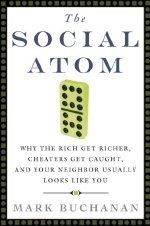Can we can ever learn to understand people and societies, businesses and other groups of all sorts, the same way we do atoms and molecules and the physical matter they make up? Are we ever going to have something like "social physics"? For centuries, philosophers and social scientists of all stripes have come up with thousands of explanations as to why we cannot; why people are essentially different and somehow stand apart from the rest of nature. The very idea of social physics, they say, is an absurdity and that's all there is to it.
Of course, we all know that people are notoriously unpredictable (or so we hear), and human psychology is immensely complicated (which is true enough). But....it seems that modern science is beginning to prove that all this talk of impossibility is probably way overblown and very, very mistaken. I've just finished writing a book called The Social Atom, due to be published by Bloomsbury Press in the U.S. in May, 2007. The book offers a snapshot, illustrated with plenty of stories, of an exploding new area of research which has shown that social physics is possible, and that science can bring the human world within its grasp -- even in strict mathematical terms.
As a book is inherently limited in what it can cover, I've started this blog as a way of taking a closer look at some of the real-world examples in the book, and as a way to explore related ideas and examples that I either didn't have space to mention there or I've learned about since then. The book covers the beginnings of a very important new movement in science -- but most of the good stuff is surely yet to come!
I think the most important idea in the entire book is the notion that our primary obstacle to understanding the human social world is our tendency to fixate on the complexity of the human individual. When we see some social surprise that we can't understand -- a riot, a sudden wave of social protest, some crazy and seemingly senseless new fashion or the unexpected collapse of a great company -- and we often think that it's the baffling behaviour of the people involved, as individuals, that leads to our puzzlement. But the real reason is often quite different -- it is not the people as individuals that confound us, but the collective social patterns that well up among them. Even if people were completely simple automatons -- with all their behaviour fully and easily predictable -- we'd still often be confused by the amazing and surprising things that happen when you put 10 or 100 of them together.
The truth is that we lack all but the most rudimentary capacity for understanding the patterns of social behaviour that emerge in our world or why they emerge so readily. In other words, we've been trained to think in exactly the wrong way. This surely sounds awfully vague and maybe a little doubtful. But it isn't, as I hope future posts will begin to make clear...
Of course, we all know that people are notoriously unpredictable (or so we hear), and human psychology is immensely complicated (which is true enough). But....it seems that modern science is beginning to prove that all this talk of impossibility is probably way overblown and very, very mistaken. I've just finished writing a book called The Social Atom, due to be published by Bloomsbury Press in the U.S. in May, 2007. The book offers a snapshot, illustrated with plenty of stories, of an exploding new area of research which has shown that social physics is possible, and that science can bring the human world within its grasp -- even in strict mathematical terms.
As a book is inherently limited in what it can cover, I've started this blog as a way of taking a closer look at some of the real-world examples in the book, and as a way to explore related ideas and examples that I either didn't have space to mention there or I've learned about since then. The book covers the beginnings of a very important new movement in science -- but most of the good stuff is surely yet to come!
I think the most important idea in the entire book is the notion that our primary obstacle to understanding the human social world is our tendency to fixate on the complexity of the human individual. When we see some social surprise that we can't understand -- a riot, a sudden wave of social protest, some crazy and seemingly senseless new fashion or the unexpected collapse of a great company -- and we often think that it's the baffling behaviour of the people involved, as individuals, that leads to our puzzlement. But the real reason is often quite different -- it is not the people as individuals that confound us, but the collective social patterns that well up among them. Even if people were completely simple automatons -- with all their behaviour fully and easily predictable -- we'd still often be confused by the amazing and surprising things that happen when you put 10 or 100 of them together.
The truth is that we lack all but the most rudimentary capacity for understanding the patterns of social behaviour that emerge in our world or why they emerge so readily. In other words, we've been trained to think in exactly the wrong way. This surely sounds awfully vague and maybe a little doubtful. But it isn't, as I hope future posts will begin to make clear...




No comments:
Post a Comment